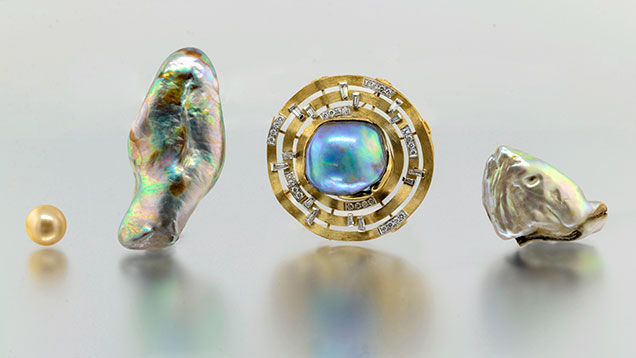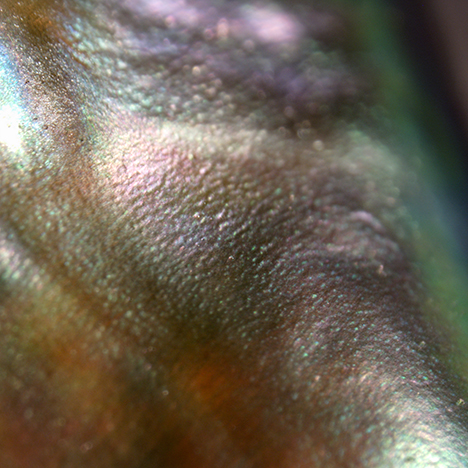Three Unique Large Natural Pearls from Haliotis (Abalone) Species

Natural abalone pearls are produced by many species of the Haliotis genus, which are ear-shaped saltwater univalve gastropods. They may form in many different sizes and shapes, though they are commonly encountered in baroque shapes, often taking the form of elongated “horns” and “teeth.” The pearls are also notable for their high luster and attractive multicolored appearance, which is usually dominated by blue, green, or yellowish green bodycolors. GIA has reported on many Haliotis pearls in previous Lab Notes over the years (Fall 1984, p. 169; Spring 1996, pp. 47–49; Fall 2004, pp. 259–260; Spring 1993, p. 51).
Three large and unique abalone pearls from a client’s collection were recently submitted to the New York laboratory (figure 1). Each piece was remarkable in its own right. A button-shaped pearl, measuring approximately 26 × 24 mm with impressive vivid “peacock” blue and green hues, was set in a yellow metal brooch. The second piece, seen in figure 1 on the far right, was a loose abalone pearl weighing 66.83 ct and measuring approximately 42 × 26 × 19 mm with a striking resemblance to a fish’s head. The eye, mouth, and gill features were clearly outlined in the specimen, which possessed a smooth surface and subtle array of iridescent greenish yellow colors. The third piece, weighing 113.58 ct and measuring approximately 62 × 29 × 16 mm, was also loose and resembled the head of a snake. It exhibited strong iridescence with mottled patches of various colors similar to the pattern observed on the scaly skin of snakes.

Microradiography revealed characteristic Haliotis-related voids with concentric growth structures in all three pearls (figure 2). Two of the pearls also revealed an iodine-rich composition, which GIA has noted is a fairly consistent property of abalone pearls. Such internal structures, along with their distinctive multicolored orient, bubble-like (botryoidal) subsurface structure (figure 3), interesting chemical composition, and chalky greenish yellow fluorescence under long-wave UV are all characteristic of abalone pearls.

The various shapes are determined by where the pearls are formed within the body of the mollusk, and often mirror the form of the gonad (E. Strack, Pearls, Ruhle-Diebener-Verlag GmbH & Co. KG, Stuttgart, 2006). Examining all three specimens at the same time allowed us to see a range of colors and shapes possible in abalone pearls. We look forward to encountering more of these unusual pearls.



